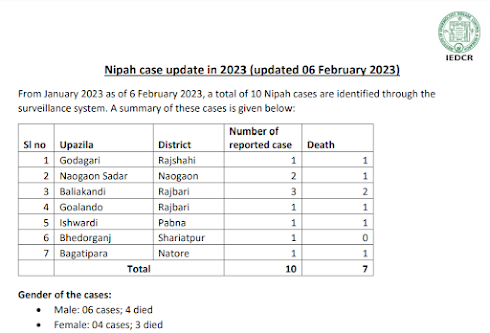
#17,275
Overnight Bangladesh's IEDCR (Institute of Epidemiology, Disease Control and Research) issued a brief update on their ongoing Nipah outbreak (see yesterday's Bangladesh: Nipah Outbreak Update & ECDC Risk Assessment) raising the number of confirmed cases to 10, and the number of fatalities to 7.
The following map shows the locations of 224 Nipah infections in Bangladesh since 2001. While the entire country is at risk, the regions reporting the most cases have been in the southern Dhaka and western Rajshani administrative divisions.
Credit IEDCR
Given the limits of testing and surveillance, it is likely that some number of cases in Bangladesh, and in neighboring countries, go unidentified each year, as the geographic range of the fruit bat that carries the virus is quite large (see map at top of blog).
Nipah often finds its way into humans via the consumption of raw date juice which can be contaminated by bat saliva and feces. Collection of date palm juice is a seasonal activity (December - May) in Bangladesh, which not surprisingly, is the same time period that defines their Nipah season.
But it can also be transmitted from human-to-human (see EID Journal Person-to-Person Transmission of Nipah Virus in a Bangladeshi Community), and potentially from contact with other infected animals (see EID Journal: Nipah Virus Exposure in Domestic and Peridomestic Animals Living in Human Outbreak Sites, Bangladesh, 2013–2015).
Outbreaks in humans since the virus was first identified in the late 1990s have tended to be sporadic, and small - although the largest, in Malaysia (1998-1999), saw 265 infected and 105 deaths.
After the 2018 outbreak in Kerala, India, concerns over larger, urban outbreaks of the virus have increased (see Enhancing preparation for large Nipah outbreaks beyond Bangladesh: Preventing a tragedy like Ebola in West Africa by Halsie Donaldson, Daniel Lucey).
Nipah, like all viruses, continues to evolve and each new human infection is another opportunity for the virus to better adapt to our physiology.
So we'll continue to monitor this - and future outbreaks of Nipah - with considerable interest.

